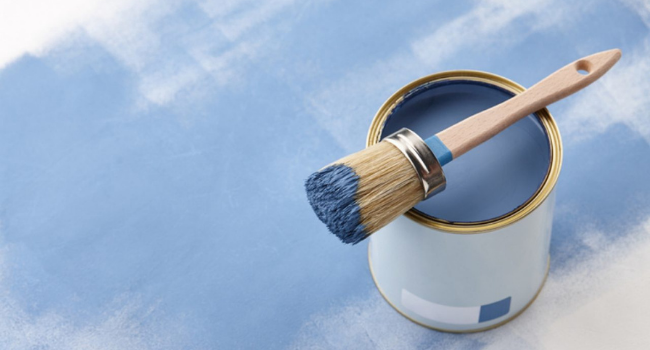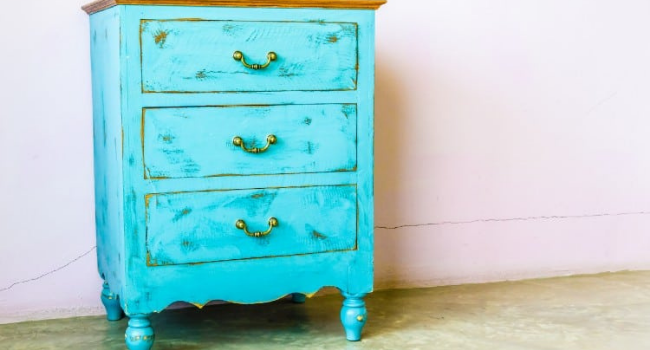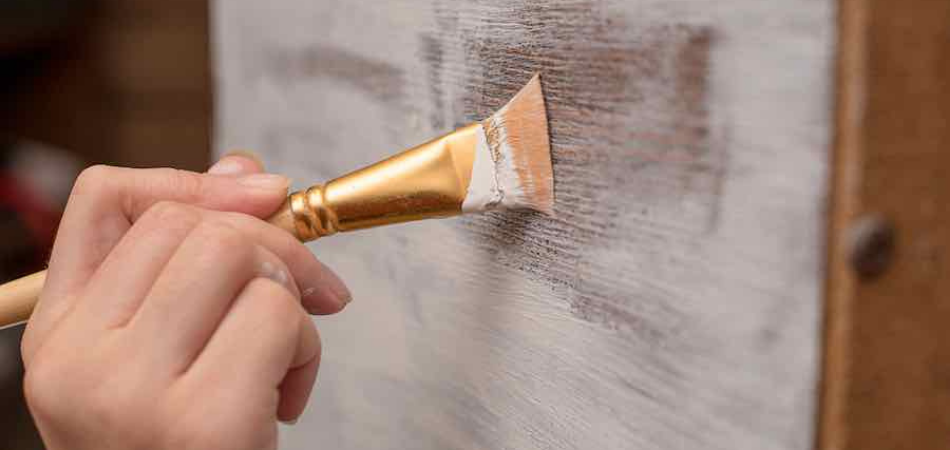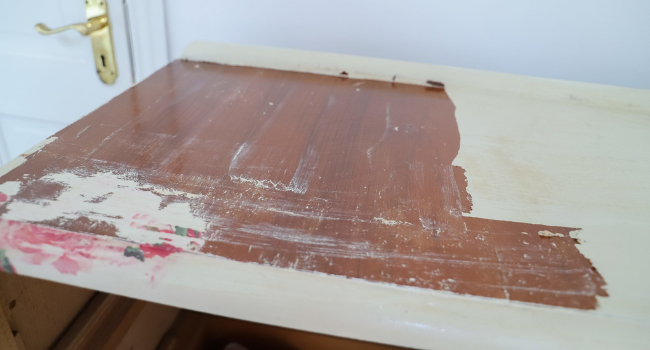Randy Charles is the owner of PaintCentric.com, a website dedicated to providing information, tips, tricks, and news about all things paint. With over 10 years...Read more
Before taking off chalk paint, it’s essential to take care. Assess the surface first, and then choose a safe method. Safety is key – don safety gear like eye protection, gloves, and clothes.

For prepping the surface for chalk paint removal, here’s what to do:
Gather supplies
Time to remove chalk paint! Gather these supplies:
- Scraper
- Drop cloths
- Painter’s tape
- White vinegar
- Paint thinner (optional)
- Rags/towels
- Latex gloves
- Eye protection
Put drop cloths on the ground around the area and use painter’s tape to protect parts you don’t want to be painted. Wear gloves and glasses before you start. Now you’re ready to get to work!
Remove any hardware
Before painting, remove any attached hardware, such as knobs, pulls, and hinges. Please put them in a bowl or container to avoid getting lost. Don’t try to take them off while the paint is still wet; it can damage the furniture.

Use a soft cloth or vacuum brush attachment to remove dirt or debris from the furniture’s surface. Sandpaper can be used to scuff the surface before you begin painting lightly. This will ensure dirt does not get trapped between layers of paint or sealant.
Removing Chalk Paint
Chalk Paint gives furniture and other items a vibrant and matte look. But you must know how to remove it when you want to update it. No worries! There are ways to safely and effectively remove the paint.
Here are some of the top methods for taking off the chalk paint:
Scrape off the paint
Scraping is the most common way to remove chalk paint. Use a putty knife, stiff brush, or something sharp with an edge. Patience is needed and work with a gentle touch.
- Begin at an angle, then hold it flat against the surface while scraping. The paint should come off easily. Thicker layers may need several scrapes.
- Stay organized by not crossing over previously scraped areas – this could damage the surface.
Use a chemical stripper.
Chemical strippers are great for removing chalk paint from furniture and other things. They work best on chalk-based paints. They are fast and efficient and don’t damage the surface or leave behind paint residue.
Before you start, read the safety instructions and wear protective gear like goggles, gloves, and a long-sleeved shirt. Use a plastic putty knife to scrape off any flaky bits of paint. Use an appropriate chemical stripper. Put it on with a brush thickly and evenly in one pass.
You may like: Is Chalk Paint Waterproof?
Let the chemical sit for up to 30 minutes to penetrate the chalk-based paint layers. Then, scrape in a downward motion with your plastic putty knife. Get rid of as much of the surface coat as you can.
Rinse off residual chemicals with hot water and a rag or sponge. Make sure all traces of chemicals are gone. Then, rinse with cold water and dry with an absorbent cloth or towel.
Apply heat to soften the paint.

Chalk paint is a unique and decorative finish made from acrylic alkyd. It can be applied on most surfaces. However, it isn’t easy to remove. Heat can help soften and scrape the paint away.
Protect nearby surfaces and objects from open flames or extreme temperatures when using heat. Fire retardant coverings should be used to avoid any damage or fire.
- For smaller areas, a hair dryer may be enough.
- For larger areas, a blowtorch or other high-heat source may be required. Consider hiring a professional for larger or multiple layers of chalk paint removal.
Removing chalk paint can be difficult. Take caution and patience when applying heat. It can damage delicate surfaces or even start a fire.
Cleaning and Finishing
Chalk paint is all the rage for sprucing up your home. But do you know how to clean and finish it? The most dependable way to take it off surfaces is with a mixture of soap and water. It’s safe, efficient and pretty simple.
Let’s go deeper into cleaning and finishing chalk paint for perfection!
Vacuum the surface
Vacuuming your chalk-painted piece can help remove dust, dirt and other particles. This will help you get a smoother finish using wax or sealant. Use a delicate tool like a soft brush attachment or an upholstery tool. You may need to use a damp rag if there are any stubborn patches or crevices. Don’t wet any bare wood, which can cause staining and warping.
Wipe down the surface.
Wait for the paint to dry before wiping off dust and dirt with a damp cloth. Check and clean the working area regularly to avoid unwanted marks.
Use a lint-free cloth and water, rubbing in even strokes. If stubborn paint remains, use 0000 steel wool or an eraser sponge.
A touch-up layer of chalk paint is suggested for furniture with a worn finish. Use either a dry brush technique or a wax finish. After the final coat is dry, apply clear or colored wax using an artistic brush.
Sand the surface
Sand the surface with medium-grit sandpaper and a sanding block for a smooth, even finish. Always sand in the same direction as the paintbrush strokes. Wipe away dust with a damp rag.
For a more distressed look, use very fine-grit sandpaper. Wipe the surface again with a damp rag. Let the painted surface dry before adding any top coats or waxes.
Finishing Touches

You’ve done it! You’ve removed the chalk paint. Now, it’s time to give your surfaces the proper finish. Applying a sealant, wax, or another protective coating to the surface after chalk paint is essential. It will help your painted surface last longer.
In this section, let’s check out the various options for final touches after chalk paint:
Apply a sealer
Once your chalk paint is dry and cured, add the final touches! A sealer will safeguard your paint from scratches or stains. It also locks in the natural properties of the chalk paint and increases its durability. You can choose matte, satin, or glossy for the final finish. The kind of sealer and finish you use will rely on the type of project you’re doing.
When applying the sealer, take your time to spread it equally with a brush or roller. Give it enough time to dry completely before using it. Depending on the surface and the desired finish, you may need several layers of sealer to obtain a smooth, even finish. Follow the coverage instructions for your product, as some brands require more coats than others for better results. Let it dry between each coat for ideal results. When done and dry, check for any remaining rough areas or imperfections— you may need to do a few touch-up strokes if needed.
Finally, dispose of any leftover sealing material according to local regulations so we can keep our environment safe!
Paint over the surface.
Once the painting is done, it’s time for the finishing touches. These will make your art stand out and show its beauty. Chalk paint is one option. It provides a soft and muted effect. When applying it, be gentle. Don’t brush too hard, or it can damage the piece. Also, remember that chalk paint is not fully opaque like most acrylics. So if full coverage is needed, use a primer or sealer first.
Another way to use chalk paint is called dry brushing. This involves lightly pushing a slightly damp brush onto the painted surface. Doing this creates contrast and texture without overpowering the item. Add waxes or varnishes to protect the masterpiece from moisture and dirt.
Reattach any hardware
The last step in your chalk paint project is to attach any hardware that has been removed. This needs patience and care – use a soft cloth to protect the paint.
- For doors, position them onto the hinges and tighten one side at a time as you adjust them. Remember to open the hinges completely before attaching. Once all hinges are secured, the furniture is ready to use!
- For furniture pieces like cabinets or chairs, insert each piece of hardware into its spot before tightening.
Wait 10-12 hours for the painted surface to cure and harden. To clean chalk paint, use a light water mist and soft microfiber cloth – this will avoid damaging your beautiful piece!
Frequently Asked Questions
What kind of tools do I need to remove chalk paint?
You will need a scraper, sandpaper, vacuum, and a damp cloth or sponge to remove chalk paint.
How do I prepare the surface for removing chalk paint?
First, scrape off any loose paint with a scraper. Then, sand the surface down with sandpaper to remove any remaining paint. Next, vacuum the surface to get rid of any dust and debris. Finally, use a damp cloth or sponge to wipe down the surface and prepare it for painting.
How do I remove the chalk paint from the surface?
There are several ways to remove chalk paint from a surface. Depending on the surface, you can use a scraper, sandpaper, chemical strippers, or power washers. Be sure to test the method you choose in an inconspicuous area first to ensure it won’t damage the surface.

Randy Charles is the owner of PaintCentric.com, a website dedicated to providing information, tips, tricks, and news about all things paint. With over 10 years of experience in the painting industry, Randy has become an expert in the field and is passionate about helping others learn more about painting. He has written numerous articles on the subject and is committed to providing accurate and up-to-date information to his readers.
